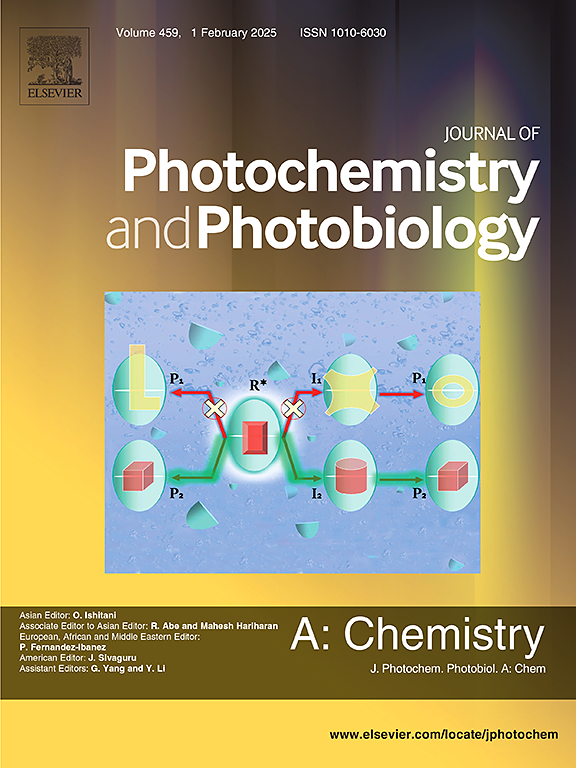Investigation of the influence of π-conjugated bridge on photovoltaic parameters in A2-π2-D-π1-A1 dye sensitizers for efficient DSSCs
IF 4.1
3区 化学
Q2 CHEMISTRY, PHYSICAL
Journal of Photochemistry and Photobiology A-chemistry
Pub Date : 2025-04-02
DOI:10.1016/j.jphotochem.2025.116407
引用次数: 0
Abstract
Most notably, indole is the most abundantly found electron donor group. Eight --D-- dyes as sensitizers to DSSCs have been successfully designed on the basis of two categories (R1/dyes and R2/dyes). All of these eight dyes have the same donor fragment (indole), π-conjugated bridge (made of thiophene moiety/benzene) and acceptor fragment (made of cyanoacrylic/cyanure). Additionally, an acceptor group (cyanoacrylic acid) is incorporated with supplementary bridge units.
The photochemical properties, electronically excited states, and chemical reactivity influencing the produced dyes have been evaluated through DFT and TD-DFT calculations. They include bond lengths, dihedral angles between fragments, frontier molecular orbitals, density of states, isosurface molecular electrostatic potential, charge density differences, fragment transition density matrix, UV–Vis absorption spectra, quantum chemical parameters, photovoltaic characteristics. The investigation compares the dyes features in photophysics, electrically excited states and chemical reactivity.
Among all the donor dyes designed, R1-D1 and R2-D1 exhibit the most favorable properties. They possess the smallest energy gap values (1.187 eV, 1.165 eV), lowest vertical excitation energies (2.32 eV, 1.85 eV), longest absorption peaks (535.51 nm, 671.67 nm), and the most negative free energy change for electron injection (−1.74 eV, −1.33 eV). These characteristics make them the optimal designs within the two molecular groups. In accordance with the appropriate photophysical characteristics expressed by the remaining organic dyes, all afore mentioned dyes can be considered suitable for application in DSSCs.

高效DSSCs染料敏化剂A2-π - 2- d -π - a1中π共轭桥对光伏参数影响的研究
最值得注意的是,吲哚是发现最多的电子供体基团。在R1/染料和R2/染料两类染料的基础上,成功设计了8种A2-π - 2- d -π - a1染料作为DSSCs的增敏剂。这8种染料都有相同的给体片段(吲哚)、π共轭桥π1(由噻吩片段/苯组成)和受体片段A1(由氰丙烯酸/氰脲组成)。此外,一个受体A2基团(氰丙烯酸)与补充桥π2单位结合。通过DFT和TD-DFT计算,评价了光化学性质、电子激发态和化学反应性对所制备染料的影响。它们包括键长、碎片之间的二面角、前沿分子轨道、态密度、等表面分子静电势、电荷密度差、碎片跃迁密度矩阵、UV-Vis吸收光谱、量子化学参数、光伏特性。比较了染料在光物理、电激发态和化学反应性方面的特性。在所有设计的给体染料中,R1-D1和R2-D1表现出最好的性能。它们具有最小的能隙值(1.187 eV, 1.165 eV),最低的垂直激发能(2.32 eV, 1.85 eV),最长的吸收峰(535.51 nm, 671.67 nm)和最大的负电子注入自由能变化(- 1.74 eV, - 1.33 eV)。这些特性使它们成为两个分子群中的最佳设计。根据剩余的有机染料所表现出的相应的光物理特性,上述染料都可以考虑在DSSCs中应用。
本文章由计算机程序翻译,如有差异,请以英文原文为准。
求助全文
约1分钟内获得全文
求助全文
来源期刊
CiteScore
7.90
自引率
7.00%
发文量
580
审稿时长
48 days
期刊介绍:
JPPA publishes the results of fundamental studies on all aspects of chemical phenomena induced by interactions between light and molecules/matter of all kinds.
All systems capable of being described at the molecular or integrated multimolecular level are appropriate for the journal. This includes all molecular chemical species as well as biomolecular, supramolecular, polymer and other macromolecular systems, as well as solid state photochemistry. In addition, the journal publishes studies of semiconductor and other photoactive organic and inorganic materials, photocatalysis (organic, inorganic, supramolecular and superconductor).
The scope includes condensed and gas phase photochemistry, as well as synchrotron radiation chemistry. A broad range of processes and techniques in photochemistry are covered such as light induced energy, electron and proton transfer; nonlinear photochemical behavior; mechanistic investigation of photochemical reactions and identification of the products of photochemical reactions; quantum yield determinations and measurements of rate constants for primary and secondary photochemical processes; steady-state and time-resolved emission, ultrafast spectroscopic methods, single molecule spectroscopy, time resolved X-ray diffraction, luminescence microscopy, and scattering spectroscopy applied to photochemistry. Papers in emerging and applied areas such as luminescent sensors, electroluminescence, solar energy conversion, atmospheric photochemistry, environmental remediation, and related photocatalytic chemistry are also welcome.

 求助内容:
求助内容: 应助结果提醒方式:
应助结果提醒方式:


